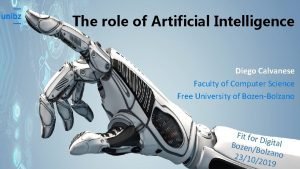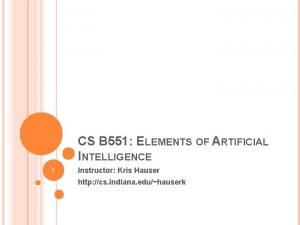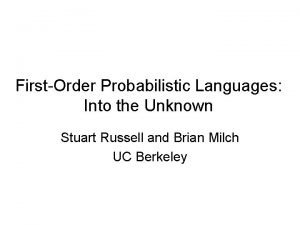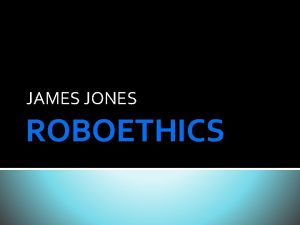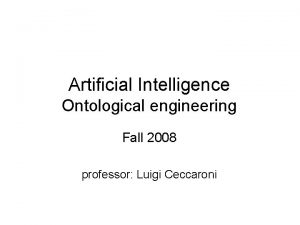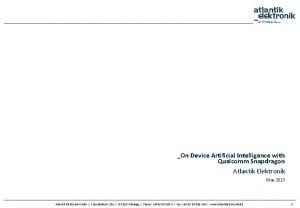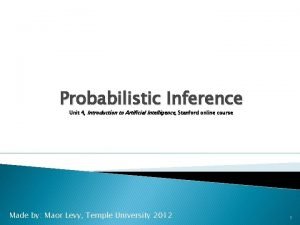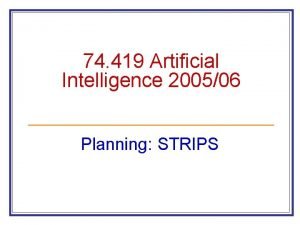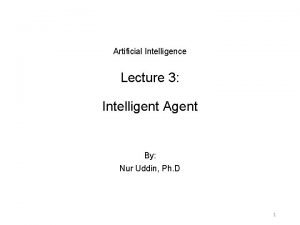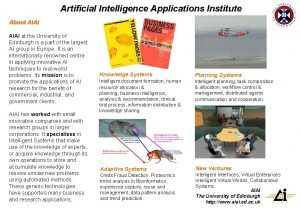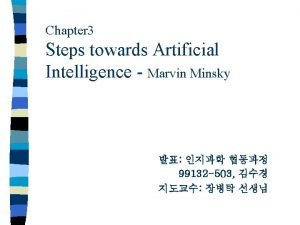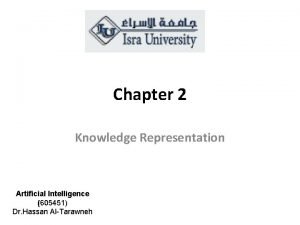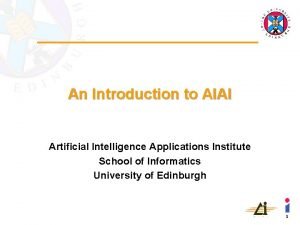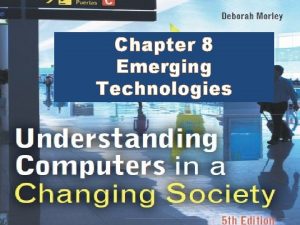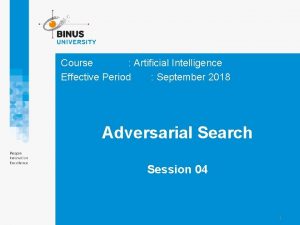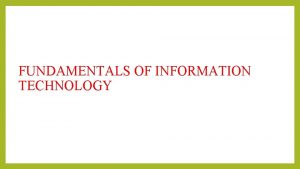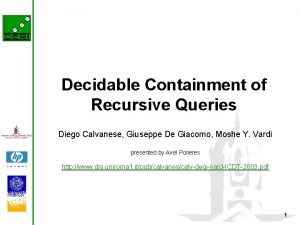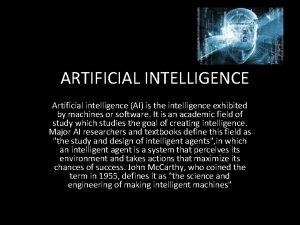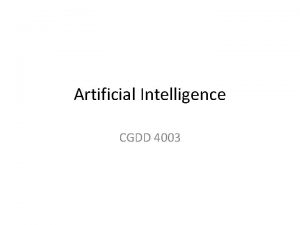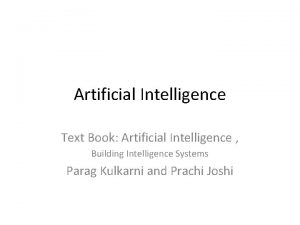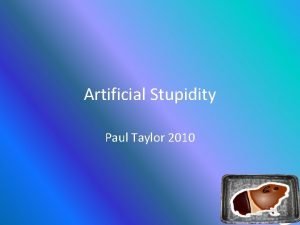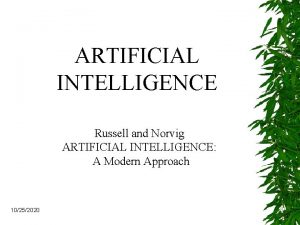The role of Artificial Intelligence Diego Calvanese Faculty





















- Slides: 21

The role of Artificial Intelligence Diego Calvanese Faculty of Computer Science Free University of Bozen-Bolzano Fit for Digital Bozen/ Bolzan o 23/10/ 2019

AI is everywhere 23/10/2019 - Diego Calvanese Fit for Digital 1

AI is everywhere 23/10/2019 - Diego Calvanese Fit for Digital 2

AI and the job market • Robots have automated routine jobs, but so far, new jobs have been created to replace old ones. • With AI, we are facing a completely new situation: Humans need to compete with machines that can outperform them in almost anything. • Economic growth is decoupled from job creation. • AI creates a “Winner-takes-all” environment. • Many jobs are at high risk of automation in the next 10 -15 years. https: //willrobotstakemyjob. com/ 23/10/2019 - Diego Calvanese Fit for Digital 3

AI in decision making • • • Selection of job applicants Performance evaluation Predictive models for crime College admission … “In all these domains availability of big data and application of AI techniques may increase inequality, bias, und unfair treatment. ” Cathy O’Neil. 20116 23/10/2019 - Diego Calvanese Fit for Digital 4

What made the recent progress in AI possible? • The underlying technology has been developed over 50 years ago: quantitative (mostly statistical analysis) approach relying on machine learning • What changed is the scale at which machine learning can now be applied: • greatly increased computing power – Moore’s Law and “the cloud” • availability of enormous amounts of data • Also: development of new statistical techniques – deep learning. Turing Award 2018 to Y. Bengio, G. Hinton, Y. Le. Cun 23/10/2019 - Diego Calvanese Fit for Digital 5

Machine/deep learning – A toy example • The aim is to capture the input/output behaviour of a system through a suitable function. • Example: recognition of a digit written in a 28 x 28 matrix of pixels • 784 inputs, one for each pixel • 10 binary outputs, each one signaling a digit • Function represented through weights on connections between nodes. • A node becomes active if the input signal is above a threshold. • Learning task is to determine the weights that provide the correct output. 23/10/2019 - Diego Calvanese Fit for Digital 6

Machine/deep learning in the ”real world” Online systems: face recognition, natural language understanding, online translation, autonomous vehicles, . . . • Inputs: come from the various types of “sensors” • Outputs: recognition of a face, natural language text, actions, . . . Offline sytems: decision making, profiling, classification, . . . • Input: data about the new case/situation to be analyzed • Output: decision taken, classification 23/10/2019 - Diego Calvanese Fit for Digital 7

The role of data There are different approaches with which AI systems learn the input/output behaviour: • Unsupervised learning • Supervised learning • Reinforcement learning In all cases, we need huge amounts of data for training. 23/10/2019 - Diego Calvanese Fit for Digital 8

Is data all we need? 23/10/2019 - Diego Calvanese Fit for Digital Bolzano – CS Meets Business – 9

We have to be careful with data 23/10/2019 - Diego Calvanese Fit for Digital 10

Causality vs. correlation 23/10/2019 - Diego Calvanese Fit for Digital Bolzano – CS Meets Business – 11

Causality vs. correlation 23/10/2019 - Diego Calvanese Fit for Digital Bolzano – CS Meets Business – 12

A problem with big data: the long tail There are situations where big data do not help. Long tail phenomenon: • Rare events play an important role. • • British National Corpus (108 words): 1, 7% occur ≤ 10 times. Search traffic on the Web: 70% is on keywords with ≤ 10 monthly occurrences [Hitwise] • To take this into account, we need to abstract and apply general principles, i. e. , make use of knowledge. 23/10/2019 - Diego Calvanese Fit for Digital Bolzano – CS Meets Business – 13

The meaning is important, not just the data Mars Climate Orbiter (1999) • Probe sent to Mars • Cost of mission: 327 M € • Probe got lost when entering Mars orbit. Problem: different teams of engineers used different measurement units. 23/10/2019 - Diego Calvanese Fit for Digital Bolzano – CS Meets Business – 14

Ask Alexa! Chi è Diomede? “È un personaggio della mitologia greca, che si è distinto come guerriero nella guerra di -BIP-. ” • Alexa has only a syntactic understanding of the terms about which she provides answers. • She lacks knowledge, i. e. , an explicit model of the data. 23/10/2019 - Diego Calvanese Fit for Digital 15

Having the wrong model can cost a lot! It was a $3. 5 billion question: was the crashing of two aeroplanes into New York’s twin towers in September 2001 one event or two? Thanks to Giancarlo Guizzardi for this nice example! 23/10/2019 - Diego Calvanese Fit for Digital Bolzano – CS Meets Business – 17

We need more than data 23/10/2019 - Diego Calvanese Fit for Digital 18

Not only data, but also knowledge • We humans constantly use background knowledge in our daily life. • Knowledge involves data, but data alone is not sufficient. • Knowledge is represented and stored as symbolic expressions. • The expressions are manipulated according to some general logic based rules, to derive new symbolic expressions that form new knowledge. Knowledge Representation Hypothesis Achieving intelligent behavior requires to store and to manipulate symbolic knowledge. 23/10/2019 - Diego Calvanese Fit for Digital 19

Where do the data come from? Public administrations collect and own lots of data! But to exploit data, it needs to be integrated • available in a single place • represented in the same formats, both logically and conceptually • cleaned and reconciled Models are key! – KR in AI deals with models • models of the data, to understand what it is about • models of the processes, to understand how data should and actually is used 23/10/2019 - Diego Calvanese Fit for Digital 20

Thanks for your attention 23/10/2019 - Diego Calvanese Fit for Digital 21
 Free car giuseppe calvanese
Free car giuseppe calvanese Csci-b 551 elements of artificial intelligence
Csci-b 551 elements of artificial intelligence Artificial intelligence: a modern approach
Artificial intelligence: a modern approach Ethics of artificial intelligence
Ethics of artificial intelligence Ontological engineering in artificial intelligence
Ontological engineering in artificial intelligence Using logic
Using logic Qualcomm smart audio 400 platform
Qualcomm smart audio 400 platform Inference by enumeration in artificial intelligence
Inference by enumeration in artificial intelligence Kecerdasan kepemimpinan
Kecerdasan kepemimpinan Pxdes expert system
Pxdes expert system Abstrips
Abstrips Omniscience in artificial intelligence
Omniscience in artificial intelligence Artificial intelligence applications institute
Artificial intelligence applications institute Xoon in artificial intelligence
Xoon in artificial intelligence Steps towards artificial intelligence
Steps towards artificial intelligence Conceptual graph in artificial intelligence tutorial
Conceptual graph in artificial intelligence tutorial References for artificial intelligence
References for artificial intelligence Artificial intelligence applications institute
Artificial intelligence applications institute Artificial intelligence devices
Artificial intelligence devices 15-780 graduate artificial intelligence
15-780 graduate artificial intelligence Optimal decisions in games in artificial intelligence
Optimal decisions in games in artificial intelligence Artificial intelligence devices
Artificial intelligence devices
